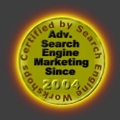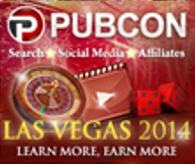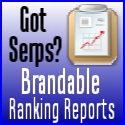 Look how old this is!
Look how old this is! I post at SearchCommander.com now, and this post was published 20 years 7 months 28 days ago. This industry changes FAST, so blindly following the advice here *may not* be a good idea! If you're at all unsure, feel free to hit me up on Twitter and ask.
Search Engine Optimization has become a multi-million dollar industry. You’ve seen the SPAM emails guaranteeing you top search results, haven’t you? It’s not uncommon to find established web designers climbing on the bandwagon and becoming experts on the subject, because they finally realize that’s what their clients need. What good is an expensive website if there’s nobody finding it online?
There are nearly as many experts as there are different theories about what works. Most of those different theories have been considered correct at one time or another. The landscape of the Search Engine world is constantly changing, and many people are spending countless hours trying to figure out what’s working and what’s not in any given month. Doing this is called “chasing the search engine algorithms”.
These algorithm chasers (of which I confess to be one) have seen some wild successes and miserable failures. We’ve seen our sites ranked in the top 10 one month, and drop completely out of sight the next month, only to return buried in the middle of the pack. Fortunately for me, I’ve learned from my mistakes, and those fluctuations are not nearly as drastic as they once were.
Increasingly popular over 2004 has been the trend for unscrupulous “web optimizers” to literally “spam” the search engines. This fools the search engine into bringing up certain pages that may not even be related what the user was actually searching for.
To keep their results clean for their users, search engines like Google CAN and DO ban domain names completely for these unscrupulous tactics, leaving the hapless business owner banned from Google, and unable to get help from their “optimizing company”. (If you’ve been banned, email me)
Through all these changes in the search engines, one thing has remained constant, and should not come as a surprise to anyone. That is that a good foundation for your website is the key to achieving successful results search rankings.
It is my hope that by giving you the foundation below, you can get an idea of how your website should be designed to be more easily found in the search engines. Whether you’ve designed your site yourself, or you’ve hired an outside firm, this information will be helpful. Armed with these facts, you can better critique your own site, or pass this information along to your staff or web designer. If you check your own site, you might be surprised at what you’ll find was done by your designer.
Bringing up your own website in Internet Explorer, and then going to View > Source will allow you to see the HTML or code that your site was written in. That code is cryptic, but not impossible to read. HTML is made up of “Tags” and of text. Listed below are the top ten most important (in my opinion) issues to consider when designing your website with respect to your “search engine friendliness”.
Title Meta Tag
The title tag is what displays in the top blue band of Internet Explorer, and what the first line of the SERP’s (Search Engine Results Pages) will show when your site is found. Your title tag of your website should be easy to read and designed to bring in traffic. Your main keyword phrase should be used toward the beginning of the tag. Do NOT make the mistake of putting your company name first, unless you believe people are searching for it that way. Your title tag should always be written with a capital letter starting the tag, and followed by all lower-case letters, (unless you’re using proper nouns). A proper title tag looks like this:
Description Meta Tag
The description tag is the paragraph that people will see when your page comes up in the search results. Your description tag should be captivating and designed to attract business. It should be easy to read, and compel the reader to act right now and follow your link. Without a description tag, search engines will frequently display the first text on your page. Is yours appropriate as a description of the page?
A proper description tag looks like this:
Keywords Meta Tag
The importance of Meta keyword tags fluctuates from month to month among different search engines. There is a debate in the SEO community as to whether or not they help at all on certain search engines. In fact, in the summer of 2004 it appeared as if they were losing importance altogether. However, you’ll NEVER be penalized on any search engines for using relevant targeted keywords in moderation, and they can only help you with most, especially Yahoo. However, avoid “stuffing” your keyword metatags with too many keywords. Just use relevant tags that apply directly to the content of that particular page, and don’t overdo it.
A proper keyword tag looks like this:
Alt Tags
The small yellow box that comes up when your mouse cursor is placed over an image is called the ALT tag. Every relevant image should have an alt tag with your key words or phrases mentioned in the tag. For example, the ALT description might be “Oregon Widget company logo” instead of “companynamelogo.jpg”.
A proper ALT tag goes after the file name, and before the Align indicator like this: (I’ve bolded it for visibility in the entire image tag)

Header Tags
The text of each page is given more weight by the search engines if you make use of header tags and then use descriptive body text below those headers. Bullet points work well too. It is not enough to merely BOLD or enlarge your text headlines.
A proper header tag looks like this:
align=”center – right etc”
Link Text
Search engine spiders cannot follow image links. In addition to having image links or buttons on your web pages, you should have text links at the bottom or elsewhere. The text that the user sees when looking at the link is called the “link text”. A link that displays “products” does not carry as much weight to the search engines as a link called “oregon widgets”. Link text is very important, and is actually one of the most frequently overlooked aspects of web design that I’ve seen.
Site Map
Using a site map not only makes it easy for your users to see the entire structure of your website, but it also makes it easier for the search engines to “spider” your site. When the search engine spiders come to visit, they will follow all of the text links from your main index page. If one of those links is to a site map, then the spiders will go right to the sitemap, and consequently visit every page you have text linked to from that site map. On the site map page, try to have a sentence or two describing each page, and not just a page of links.
Relevant Inbound Links
By relevant, I mean similar industry or subject related sites. Right now, no single strategy can get your site ranked higher faster than being linked to by dozens of other relevant websites. It used to be that the quantity of incoming links mattered most, but today, in November 2004, it’s much better to have three highly relevant links to you from other popular related websites than 30 links from unrelated low ranked sites. If there are other businesses in your industry that you can trade links with, it will help your site enormously. Link to others, and have them link to you. It’s proven, and it works. To see who’s linking to you, in Google type the following…
links: yourdomain.com
Your Content
Not to be forgotten of course, is the actual content of your webpage. It must be relevant helpful information that people want to read. These days, each webpage should be laser focused on one specific product or subject, in order to rank highly for that search phrase. The days of writing one webpage to appeal to dozens of search terms are long gone.
Ideally, each page should have between 400 to 650 words on it. Too few, and the search engines won’t consider it to be relevant enough. Too many words and the search engine spiders may have a hard time determining the actual subject or focus of the page.
Use your keywords or phrases often, and use them at the beginning of your paragraphs wherever possible. Don’t overuse them and make the page sound phony, but don”t write a page about a certain subject, and not mention that subject repeatedly either. Reading it out loud to yourself is a great way to judge how natural your text sounds.
Concentrate on writing quality pages that actually appeal to the human reader. Write pages that provide the reader with exactly what they are looking for; that is, information about the exact search phrase they’ve entered.
Avoid Cheating
With all of these tidbits of information, it’s tempting to think that you can stuff 100 keywords into your title, or create a page with the phrase “oregon widget company” being used 100 times in headers, text links, ALT tags, bullet points etc. but that cannot help you. In fact, it can penalize you, and get your website banned from certain search engines.
As search engine robots continue to utilize better types of AI (Artificial Intelligence) they will in effect, get smarter. They are already starting to look for things the same way you and I do; with the highest relevance given to pages that directly relate to information about their exact search phrase.
(note the previous url for this page was /200411-seofoundation.php)



















